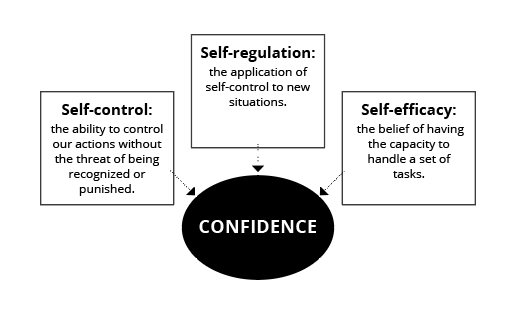The 6 C's of Positive Youth Development: Confidence Drives Success
Angie, the grocery store manager, wants Jasmine to apply for the assistant manager position. To motivate her, Angie asked Jasmine to be her assistant for a day. This way, Jasmine can get a preview of the position and decide for herself if she’s willing to fulfill the expectations. Jasmine accepted the invitation, and by the end of the day, she felt competent and confident enough to apply for the position. Angie couldn’t be happier!
If you identify with Angie, this publication is for you! It’s the second of six publications from the Positive Youth Development (PYD) Series, and it centers on youth confidence as a success factor.
Mississippi 4-H is a youth organization made up of Extension Agents, volunteers, and caring adults who utilize the 6 C’s of Positive Youth Development to help young people develop the competencies for life-long success. While this publication is intended for adults working with young people in the 4-H youth development program, it applies to adults who work with youth across a variety of programs.
______________________________________________________________________________________________________________
Programs that promote positive youth development need to offer supportive and safe spaces for young people to learn from their mistakes, practice mindfulness, and self-reflect on their behavior. Youth crave strong, stable, and trustworthy relationships with people to whom they can relate and go to for advice. Relationships are based on confidence, and to provide that to PYD program participants, you must first have it within yourself.
Confidence drives every aspect of our lives, from our personal affairs to how we treat others, but what does confidence mean? How can you learn to trust yourself and teach that practice to others? If you’ve asked yourself this, you’ve come to the right place.
The 3 Pillars of Confidence
To build confidence, you need to explore new surroundings, engage in different conversations, do different activities, and meet new people. You need to step out of your comfort zone because it will help you adapt your behavior to different situations, like a new job, starting college, or moving to a new town. Absorbing and applying new information leads to the development of competence which tends to increase confidence. Three pillars build confidence: self-control, self-regulation, and self-efficacy. When you’re able to control your actions in new situations and feel competent enough to handle a set of tasks, you are adapting to a new scenario, and this builds confidence. The combination of self-efficacy, self-control, and self-regulation paves the road to success.

Programs can incorporate confidence “boot camps” or short courses to target the skills that improve it. This can have a positive effect on task performance, enthusiasm, and the willingness to perform new skills. Youth need something to boost their confidence, and sometimes, all it takes is a little push. The positive pathway to confidence training looks like this (adapted from Clanton et al., 2014):
Training → Confidence → Motivation → Practice → Experience → Even more confidence!
Confidence boosting strategies
Here are some strategies that can foster confidence in youth (and adults too!):
- Ask questions and offer positive feedback.
Often, young people don’t know what they know. Asking questions and allowing them to think for themselves can demonstrate how much they know and what they are capable of. Offer positive feedback as encouragement. - Recognize and praise their abilities.
Demonstrate a genuine interest in what young people are doing to make them feel valued. Try not to focus on the negative and be sure to celebrate their efforts. If you show them that you believe in them, they will believe in themselves. - Lead by example.
Young people can perceive when you are insecure and may lose interest, so having self-confidence is key. This doesn’t mean that you must be perfect, but you can recognize and acknowledge your mistakes. They will respect you more when you accept that you are human like them. - Provide time for growth.
PYD programs should provide opportunities for youth to put their confidence to the test and adults should be the biggest cheerleaders! If youth still feel insecure, don’t judge them negatively. Give them more time to master the skill and try again when they feel ready. - Allow personal identity to express itself.
PYD programs should foster hope and optimism to help young people envision a positive, successful, and realistic future. When youth have control over their actions, can adapt to new situations, and believe in their capacity, they’re unstoppable.
If you would like to know what young people have gained through participation in a program, you can use the Positive Youth Development Instrument to find out. It’s a series of questions that you can ask before the program starts and again after it ends to evaluate what participants learned. You can use the following table as a guide.
|
Tell us how strongly you agree or disagree with |
Strongly disagree |
Disagree |
Neither agree nor disagree |
Agree |
Strongly agree |
|
I feel good about my scholastic ability. |
|||||
|
I feel I am a good athlete. |
|||||
|
I am satisfied with how I look. |
|||||
|
I feel accepted by my friends. |
|||||
|
In general, I think I am a worthy person. |
|||||
|
I know how to behave well in different settings. |
|||||
|
I can figure out right from wrong. |
|||||
|
I have close friendships. |
|||||
|
I can do things that make a difference. |
Adapted from Arnold et al., (2012)
Summary
Building self-confidence is a lifelong process that doesn’t happen overnight! Understanding how to develop confidence early sets the tone for a healthy life. Remember, confidence stands on three pillars of self-control, self-regulation, and self-efficacy— which all nurture independence in thought and in action. To boost youth confidence:
- ask questions and offer positive feedback,
- recognize and praise their abilities,
- lead by example,
- provide time for growth, and
- allow personal identity to express itself.
PYD programs should train their adults to efficiently transfer their confidence to youth.
Angie knows that Jasmine’s new role may cause some friction among the employees, especially those that are older than her, but she’s confident of Jasmine’s conflict resolution skills. As things get heated in the cash registers during rush hour, Jasmine puts her skills to the test, and most of all, her character, the third C of PYD.
Confidence is the second C of PYD and in the next publication, Jasmine will demonstrate the third C of PYD, character.
References
Arnold, M. E., Nott, B. D., & Meinhold, J. L. (2012). The Positive Youth Development Inventory Full Version. © Oregon State University. All Rights Reserved.
Arnone, M. P., Small, R. V., & Reynolds, R. (2010). Supporting Inquiry by Identifying Gaps in Student Confidence: Development of a Measure of Perceived Confidence. School Libraries Worldwide, 16 (1), 47-60.
Brumbaugh, L., & Cater, M. The Perceived Importance of Youth Educator’s Confidence in Delivering Leadership Development Programming. Journal of Leadership Education, 15 (1).
Clanton, J., Gardner, A., Cheung, M., Mellert, L., Evancho-Chapman, M., & George, R. L. (2014). The Relationship Between Confidence and Competence in the Development of Surgical Skills. Journal of Surgical Education, 405-412.
Gloppen, K. M., David-Ferdon, C., & Bates, J. (2009). Confidence as a Predictor of Sexual and Reproductive Health Outcomes for Youth. Journal of Adolescent Health, 46 (2010), S42-S58.
Posner, B.Z., & Kouzes, J. M. (1997). Ten Lessons for Leaders and Leadership Developers. Journal of Leadership and Organizational Studies, 3 (3), 3-10.
Worker, S. M., Iaccopucci, A. M., Bird, M., & Horowitz, M. (2019). Promoting Positive Youth Development Through Teenagers-as-Teachers Programs. Journal of Adolescent Research, 34 (1), 3054.
___________________________________________________________________________________
Publication 3933
By Patricia Marie Cordero-Irizarry, Doctoral Student, Agricultural and Extension Education; Mariah Smith Morgan, PhD, Associate Extension Professor, and Donna J. Peterson, PhD, Extension Professor, Human Sciences.
The Mississippi State University Extension Service is working to ensure all web content is accessible to all users. If you need assistance accessing any of our content, please email the webteam or call 662-325-2262.


